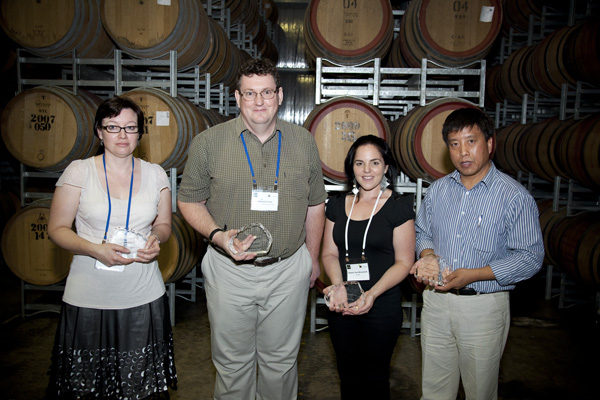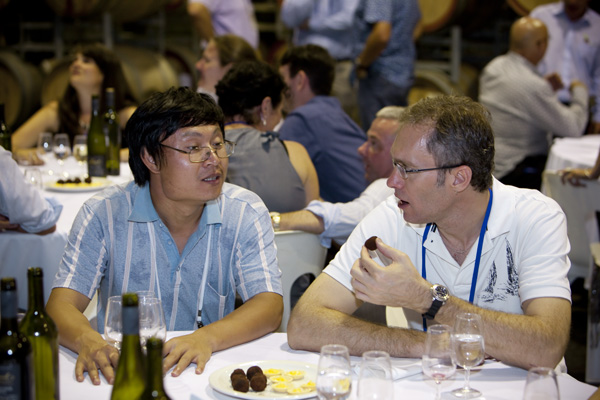Researchers recognised at Science Exchange Awards Dinner
To recognise the success, dedication and achievements of the researchers and participants of the Cooperative Research Centre for National Plant Biosecurity, the 2011 Awards Dinner was held at the beautiful Langmeil Winery in the Barossa Valley on Thursday 10 February.
The dinner was held in celebration of the work that has been undertaken throughout the past year and is a chance to reward the outstanding achievements in discovering and implementing solutions to plant biosecurity issues.
The evening began with pre dinner drinks between two of the vineyards, which provided a spectacular backdrop to start the night. While enjoying a drop of the local produce, attendees were treated to a talk by one of Langmeil’s employees, Jonathan Bitter, who explained the history of the Barossa Valley and the winery itself and gave an overview of the viticulture industry and the biosecurity issues it continues to face.
.jpg)
Attendees are treated to a talk from Langmeil's Jonathan Bitter in the vineyards.
From the vineyards guests moved in to one of the barrel rooms, where a set seating plan ensured guests had further networking opportunities over dinner.
.jpg)
Dinner in the barrel room at Langmeil Winery.
Board member Barry Windle was master of ceremonies for the evening and started out by celebrating the successes of the CRC. Barry then invited fellow Board member Jim Cullen to the stage to present the first awards for the night, the Poster Awards.
The winners were:
- Board Award for Best Poster – Kelly Bailey for her poster titled Investigating the receptors involved in chemical communication for the pest beetle Tribolium castaneum.
- Board Award for best Student Poster – Brian Garms for his poster titled The South African Citrus Thrips (Scirtothrips aurantii) in Queensland, which is highly polyphagous and does not show strong preferences for its only recorded host in the field.
- People’s Choice Award for Best Poster – Rebecca Zappia for her poster titled Sampling irrigation water for plant pathogens – coherently working together or organised chaos?
.jpg)
Rebecca Zappia, Kelly Bailey and Brian Garms after receiving their awards.
Following the poster awards guests were treated to a delicious catered meal from Maggie Beer’s farm, before Barry introduced the guest speaker for the evening, Johann van der Merwe.
Johann is internationally recognised for protected area management, conservation planning, and biosecurity. He was the Director for South African National Parks, an organisation entrusted with the management of some of the world’s most vulnerable and irreplaceable biodiversity.
Johann is currently responsible for setting up a dedicated Quarantine Management System for the Gorgon Project on Barrow Island, which the CRCNPB has provided scientific advice on a consultancy basis.
.jpg)
Barry Windle thanks Johann van der Merwe for his key note speech.
At the conclusion of his key note speech, the CRCNPB’s Principal Scientist, James Ridsdill-Smith was called on to present the Science Committee Awards. After giving some background as to how the project teams were nominated, the awards were presented to the following recipients:
Collaboration Award – Sharyn Taylor on behalf of the Grains Knowledge Networks project team (CRC70096). The project was nominated for successfully bringing together many elements of the grains industry including bulk handlers, state departments of agriculture, Grains Research and Development Corporation (GRDC), Department of Agriculture, Fisheries and Forestry (DAFF), CSIRO and Plant Health Australia (PHA) to work together and develop and agree to a strategy aimed at extending the life of phosphine as the fumigant of choice for the Australian grains industry – a significant task that the project managed to accomplish. The project has been instrumental in establishing Grains Biosecurity Officers across the mainland states to work with departmental extension officers and GRDC to encourage the implementation of the best practice strategy, overcoming traditional jurisdictional barriers and providing a national approach to grains biosecurity.
Other finalists for the award were:
- CRC60103: The role of communities in biosecurity management – citrus production in West Timor as a case study
- CRC40088: Pre-harvest fruit fly
Innovation Award – PhD student Sharon van Brunschot for her project which is looking at Novel detection assays for the tomato leaf curl complex of geminiviruses (CRC60070). The project team was nominated for work on a new technology platform, nanoscaled biosensors, for the multiplex detection of begomoviruses. She is part of the larger nanotechnology project based in Queensland. Despite facing problems with the original nanobeads, Sharon has developed and published new molecular diagnostic methods for viruses, and is now working with researchers in the Netherlands to assess the use of The Luminex® platform for high-throughput nucleic acid detection of plant viruses and vectors in Australia.
Other finalists for the award were:
Impact on Industry Award – YongLin Ren on behalf of the project team who are looking for alternatives to the use of phosphine as a grain fumigant (CRC50147). For the first time internationally, in collaboration with farmers and grain companies, this project team is developing low oxygen technology as a practical, cost-effective commercial alternative to phosphine fumigation for the treatment of grain. This development is supported by detailed research on the effects of low oxygen on insect pests, grain in storage and grain quality. Low oxygen will provide the industry with a complete no-chemical treatment and a viable alternative to phosphine.
Other finalists for the award were:
Science Excellence Award - Tony Clarke on behalf of the Resolving the Bactrocera dorsalsis complex project team (CRC20115). The team that scoped the project recognised the need to address a complex but fundamental problem in biosecurity with a multi-disciplinary approach. As a result the project brings together elements of molecular, morphological and behavioural biology to address species distinctions in the dorsalis complex - this is a strongly and genuinely collaborative project. Prime evidence of science excellence is the independent and international validation of the approach taken. The model used by this project has been adopted as the project structure for a multinational, IAEA-led project to look at resolving cryptic species complexes in insects, with this project team, and the dorsalis complex, as a focus of activity.
Other finalists for the award were:
- CRC60076: Confidence levels for Emergency Plant Pest detection and response to incursion
- CRC10001: Early Warning Threat Identification

Sharyn Taylor, Tony Clarke, Sharon van Brunschot and YongLin Ren after being presented with their respective awards.
The final awards presented for the evening were the Board Awards for Commitment, which were awarded for meeting the following criteria:
1. Not be limited to science or project staff, activities or results
2. For a person, group or organisation demonstrating outstanding contribution and/or commitment, and/or
3. For commitment to work in the face of extraordinary personal or work circumstances, or
4. For commitment to an industry, region or state biosecurity objectives beyond normal expectations, or
5. For going the extra mile in any other extraordinary way that is important to the CRC.
The Board awarded four recipients:
- Alison Mackie - PhD candidate CRCNPB
- Lachlan Dobson - Farmer, PhD supervisor
- Satendra Kumar - Director Plant Biosecurity NSW Industry & Investment
- Gordon Gordh - Science Advisor United States Department of Agriculture
Following the formalities, guests had the opportunity to mingle and enjoy the final social networking opportunity of the Science Exchange.

Guests enjoy the remainder of the evening.
Photographs by Barossa Photo Company. The full Science Exchange album is available here.

